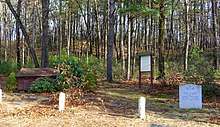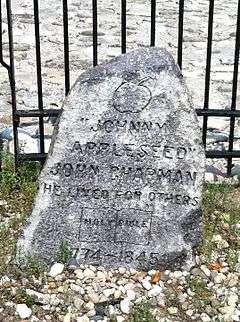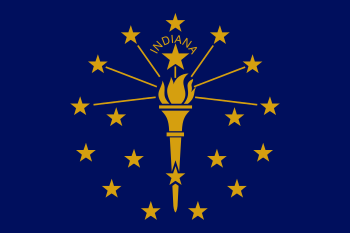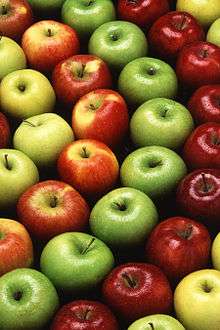Johnny Appleseed
John Chapman (September 26, 1774 – March 18, 1845), better known as Johnny Appleseed, was an American pioneer nurseryman who introduced apple trees to large parts of Pennsylvania, Ontario, Ohio, Indiana, and Illinois, as well as the northern counties of present-day West Virginia. He became an American legend while still alive, due to his kind, generous ways, his leadership in conservation, and the symbolic importance he attributed to apples. He was also a missionary for The New Church (Swedenborgian)[1] and the inspiration for many museums and historical sites such as the Johnny Appleseed Museum[2] in Urbana, Ohio, and the Johnny Appleseed Heritage Center[3] in Ashland County, Ohio.[upper-alpha 1] The Fort Wayne TinCaps, a minor league baseball team in Fort Wayne, Indiana, where Chapman spent his final years, is named in his honor.[4]
Johnny Appleseed | |
|---|---|
 Image from Howe's Historical Collection | |
| Born | John Chapman September 26, 1774 |
| Died | March 18, 1845 (aged 70) Fort Wayne, Indiana, U.S. |
| Nationality | American |
| Occupation | Missionary and gardener |
Family

Chapman was born on September 26, 1774, in Leominster, Massachusetts,[5] the second child of Nathaniel and Elizabeth Chapman (née Simonds, married February 8, 1770). His birthplace has a granite marker, and the street is now called Johnny Appleseed Lane.
Chapman's mother, Elizabeth, died in 1776 shortly after giving birth to a second son, Nathaniel Jr., who died a few days later. His father, Nathaniel, who was in the military, returned in 1780 to Longmeadow, Massachusetts, where, in the summer of 1780, he married Lucy Cooley.[1][6]
According to some accounts, an 18-year-old John persuaded his 11-year-old brother Nathaniel Cooley Chapman to go west with him in 1792. The duo apparently lived a nomadic life until their father brought his large family west in 1805 and met up with them in Ohio. The younger Nathaniel decided to stay and help their father farm the land.
Shortly after the brothers parted ways, John began his apprenticeship as an orchardist under a Mr. Crawford, who had apple orchards, thus inspiring his life's journey of planting apple trees.[7]
Life
There are stories of Johnny Appleseed practicing his nurseryman craft in the area of Wilkes-Barre, Pennsylvania, and of picking seeds from the pomace at Potomac River cider mills in the late 1790s.[1] Another story has Chapman living in Pittsburgh on Grant's Hill in 1794 at the time of the Whiskey Rebellion.[8]
The popular image is of Johnny Appleseed spreading apple seeds randomly everywhere he went. In fact, he planted nurseries rather than orchards, built fences around them to protect them from livestock, left the nurseries in the care of a neighbor who sold trees on shares, and returned every year or two to tend the nursery. He planted his first nursery on the bank of Brokenstraw Creek, south of Warren, Pennsylvania. Next, he seems to have moved to Venango County, along the shore of French Creek,[9] but many of these nurseries were in the Mohican River area of north-central Ohio. This area included the towns of Mansfield, Lisbon, Lucas, Perrysville, and Loudonville.[10]
According to Harper's New Monthly Magazine, toward the end of his career he was present when an itinerant missionary was exhorting an open-air congregation in Mansfield, Ohio. The sermon was long and severe on the topic of extravagance, because the pioneers were buying such indulgences as calico and imported tea. "Where now is there a man who, like the primitive Christians, is traveling to heaven barefooted and clad in coarse raiment?" the preacher repeatedly asked until Johnny Appleseed, his endurance worn out, walked up to the preacher, put his bare foot on the stump that had served as a podium, and said, "Here's your primitive Christian!" The flummoxed sermonizer dismissed the congregation.[11]
He would tell stories to children and spread The New Church gospel to the adults, receiving a floor to sleep on for the night, and sometimes supper, in return. "We can hear him read now, just as he did that summer day, when we were busy quilting upstairs, and he lay near the door, his voice rising denunciatory and thrillin—strong and loud as the roar of wind and waves, then soft and soothing as the balmy airs that quivered the morning-glory leaves about his gray beard. His was a strange eloquence at times, and he was undoubtedly a man of genius," reported a lady who knew him in his later years.[12] He made several trips back East, both to visit his sister and to replenish his supply of Swedenborgian literature.
He preached the gospel as he traveled, and during his travels he converted many Native Americans, whom he admired. The Native Americans regarded him as someone who had been touched by the Great Spirit, and even hostile tribes left him strictly alone.[13]
He cared very deeply about animals, including insects. Henry Howe visited all the counties in Ohio in the early nineteenth century and collected several stories from the 1830s, when Johnny Appleseed was still alive:[14]
One cool autumnal night, while lying by his camp-fire in the woods, he observed that the mosquitoes flew in the blaze and were burned. Johnny, who wore on his head a tin utensil which answered both as a cap and a mush pot, filled it with water and quenched the fire, and afterwards remarked, "God forbid that I should build a fire for my comfort, that should be the means of destroying any of His creatures." Another time, he allegedly made a camp-fire in a snowstorm at the end of a hollow log in which he intended to pass the night but found it occupied by a bear and cubs, so he removed his fire to the other end and slept on the snow in the open air, rather than disturb the bear.
In a story collected by Eric Braun,[15] he had a pet wolf that had started following him after he healed its injured leg.
More controversially, he also planted dogfennel during his travels, believing that it was a useful medicinal herb. It is now regarded as a noxious, invasive weed.[16]
According to another story, he heard that a horse was to be put down, so he bought the horse, bought a few grassy acres nearby, and turned it out to recover. When it did, he gave the horse to someone needy, exacting a promise to treat it humanely.[17]
During his later life, he was a vegetarian.[18] He never married. He thought he would find his soulmate in heaven if she did not appear to him on earth.[19]
Death


Different dates are listed for his death. Harper's New Monthly Magazine of November 1871 was apparently incorrect in saying that he died in mid 1847, though this is taken by many as the primary source of information about John Chapman.[11] Multiple Indiana newspapers reported his death date as March 18, 1845. The Goshen Democrat published a death notice for him in its March 27, 1845, edition, citing the day of death as March 18 of that year. The paper's death notice read:
In Fort Wayne, on Tuesday, 18th, inst John Chapman, commonly known by the name of Johnny Appleseed, about 70 years of age. Many of our citizens will remember this eccentric individual, as he sauntered through town eating his dry rusk and cold meat, and freely conversing on the mysteries of his religious faith. He was a devoted follower of Emanuel Swedenborg, and notwithstanding his apparent poverty, was reputed to be in good circumstances.
The Fort Wayne Sentinel printed his obituary on March 22, 1845, saying that he died on March 18:[20]
On the same day in this neighborhood, at an advanced age, Mr. John Chapman (better known as Johnny Appleseed).
The deceased was well known through this region by his eccentricity, and the strange garb he usually wore. He followed the occupation of a nurseryman, and has been a regular visitor here upwards of 10 years. He was a native of Pennsylvania we understand but his home—if home he had—for some years past was in the neighborhood of Cleveland, where he has relatives living. He is supposed to have considerable property, yet denied himself almost the common necessities of life—not so much perhaps for avarice as from his peculiar notions on religious subjects. He was a follower of Swedenborg and devoutly believed that the more he endured in this world the less he would have to suffer and the greater would be his happiness hereafter—he submitted to every privation with cheerfulness and content, believing that in so doing he was securing snug quarters hereafter.
In the most inclement weather he might be seen barefooted and almost naked except when he chanced to pick up articles of old clothing. Notwithstanding the privations and exposure he endured, he lived to an extreme old age, not less than 80 years at the time of his death—though no person would have judged from his appearance that he was 60. "He always carried with him some work on the doctrines of Swedenborg with which he was perfectly familiar, and would readily converse and argue on his tenets, using much shrewdness and penetration.
His death was quite sudden. He was seen on our streets a day or two previous.
The site of his grave is also disputed. Developers of the Canterbury Green apartment complex and golf course in Fort Wayne, Indiana, claim that his grave is there, marked by a rock. That is where the Worth cabin sat in which he died.[21]41°6′36″N 85°7′25″W
Steven Fortriede, director of the Allen County Public Library (ACPL) and author of the 1978 Johnny Appleseed, believes that another gravesite is the correct site, in Johnny Appleseed Park in Fort Wayne.[21][22] Johnny Appleseed Park is a Fort Wayne city park that adjoins Archer Park, an Allen County park. Archer Park is the site of John Chapman's grave marker and used to be a part of the Archer family farm.
The Worth family attended First Baptist Church in Fort Wayne, according to records at ACPL, which has one of the nation's top genealogy collections.[23] According to an 1858 interview with Richard Worth Jr., Chapman was buried "respectably" in the Archer cemetery, and Fortriede believes that use of the term "respectably" indicates that Chapman was buried in the hallowed ground of Archer cemetery instead of near the cabin where he died.[21]
John H. Archer, grandson of David Archer, wrote in a letter[24] dated October 4, 1900:
The historical account of his death and burial by the Worths and their neighbors, the Pettits, Goinges, Porters, Notestems, Parkers, Beckets, Whitesides, Pechons, Hatfields, Parrants, Ballards, Randsells, and the Archers in David Archer's private burial grounds is substantially correct. The grave, more especially the common head-boards used in those days, have long since decayed and become entirely obliterated, and at this time I do not think that any person could with any degree of certainty come within fifty feet of pointing out the location of his grave. Suffice it to say that he has been gathered in with his neighbors and friends, as I have enumerated, for the majority of them lie in David Archer's graveyard with him.
The Johnny Appleseed Commission Council of the City of Fort Wayne reported, "[A]s a part of the celebration of Indiana's 100th birthday in 1916 an iron fence was placed in the Archer graveyard by the Horticulture Society of Indiana setting off the grave of Johnny Appleseed. At that time, there were men living who had attended the funeral of Johnny Appleseed. Direct and accurate evidence was available then. There was little or no reason for them to make a mistake about the location of this grave. They located the grave in the Archer burying ground."[25]
Legacy
.jpg)
Johnny Appleseed left an estate of over 1,200 acres (490 ha) of valuable nurseries to his sister.[26] He also owned four plots in Allen County, Indiana, including a nursery in Milan Township with 15,000 trees,[21] and two plots in Mount Vernon, Ohio.[27][28] He bought the southwest quarter (160 acres) of section 26, Mohican Township, Ashland County, Ohio, but he did not record the deed and lost the property.[16]
The financial panic of 1837 took a toll on his estate.[17] Trees brought only two or three cents each,[17] as opposed to the "fippenny bit" (about six and a quarter cents) that he usually got.[29] Some of his land was sold for taxes following his death, and litigation used up much of the rest.[17]
Fort Wayne, Indiana, is the location of Johnny Appleseed's death.[30] A memorial in Fort Wayne's Swinney Park[31] purports to honor him but not to mark his grave. In Fort Wayne, since 1975, the Johnny Appleseed Festival has been held the third full weekend in September in Johnny Appleseed Park and Archer Park. Musicians, demonstrators, and vendors dress in early-19th-century attire and offer food and beverages that would have been available then.[32] In 2008 the Fort Wayne Wizards, a minor league baseball club, changed their name to the Fort Wayne TinCaps. The first season with the new name was in 2009. That same year the Tincaps won their only league championship. The name "Tincaps" is a reference to the tin hat (or pot) Johnny Appleseed is said to have worn. Their team mascot is also named "Johnny."
From 1962 to 1980, a high school athletic league made up of schools from around the Mansfield, Ohio, area was named the Johnny Appleseed Conference.
In 1966, the U.S. Postal Service issued a 5-cent stamp commemorating Johnny Appleseed.[33][34]
A memorial in Spring Grove Cemetery in Cincinnati, Ohio is on the summit of the grounds in Section 134. A circular garden surrounds a large stone upon which a bronze statue of Chapman stands, face looking skywards, holding an apple seedling tree in one hand and a book in the other. A bronze cenotaph identifies him as Johnny Appleseed with a brief biography and eulogy.
March 11 and September 26 are sometimes celebrated as Johnny Appleseed Day. The September date is Appleseed's acknowledged birthdate, but the March date is sometimes preferred because it is during planting season.
Johnny Appleseed Elementary School is a public school in Leominster, Massachusetts, his birthplace. Mansfield, Ohio, one of Appleseed's stops in his peregrinations, was home to Johnny Appleseed Middle School until it closed in 1989.
The village of Lisbon, Ohio, hosts an annual Johnny Appleseed festival September 18–19.
A large terracotta sculpture of Johnny Appleseed, created by Viktor Schreckengost, decorates the front of the Lakewood High School Civic Auditorium in Lakewood, Ohio. Although the local board of education deemed Appleseed too "eccentric" a figure to grace the front of the building, renaming the sculpture simply "Early Settler," students, teachers, and parents alike still call the sculpture by its intended name: "Johnny Appleseed."[35]
Urbana University, in Urbana, Ohio, maintains one of two Johnny Appleseed Museums in the world, which is open to the public. The Johnny Appleseed Educational Center and Museum hosts a number of artifacts, including a tree that is believed to have been planted by Johnny Appleseed. They also provide a number of services for research, including a national registry of Johnny Appleseed's relatives. In 2011 the museum was renovated and updated. The educational center and museum was founded on the belief that those who have the opportunity to study the life of Johnny Appleseed will share his appreciation of education, our country, the environment, peace, moral integrity and leadership.[36]
Supposedly, the only surviving tree planted by Johnny Appleseed is on the farm of Richard and Phyllis Algeo of Nova, Ohio.[37] Some marketers claim it is a Rambo.[38] Some even make the claim that the Rambo was "Johnny Appleseed's favorite variety",[39] ignoring that he had religious objections to grafting and preferred wild apples to all named varieties. It appears most nurseries are calling the tree the "Johnny Appleseed" variety, rather than a Rambo. Unlike the mid-summer Rambo, the Johnny Appleseed variety ripens in September and is a baking-applesauce variety similar to an Albemarle Pippin. Nurseries offer the Johnny Appleseed tree as an immature apple tree for planting, with scions from the Algeo stock grafted on them.[40] Orchardists do not appear to be marketing the fruit of this tree.
Apple cider
Author Michael Pollan believes that since Chapman was against grafting, his apples were not of an edible variety and could be used only for cider: "Really, what Johnny Appleseed was doing and the reason he was welcome in every cabin in Ohio and Indiana was he was bringing the gift of alcohol to the frontier. He was our American Dionysus."[41][42]
See also
- Folk hero
- Seed bombing
- Tree planting
- Silviculture
- The Man Who Planted Trees
References
Notes
- Between Lucas and Mifflin, Ohio.
Citations
- "John Chapman". Swedenborg.org. Archived from the original on May 17, 2015. Retrieved June 6, 2015.
- "Johnny Appleseed Education Center & Museum". Urbana.edu. Archived from the original on June 26, 2015. Retrieved June 6, 2015.
- "The Johnny Appleseed Outdoor Drama". Archived from the original on November 28, 1999. Retrieved September 5, 2006.
- "Scout.com: Fort Wayne no longer the Wizards". www.scout.com. Archived from the original on June 19, 2017. Retrieved June 7, 2017.
- Means, Howard (2011). Johnny Appleseed: The Man, the Myth, the American Story. New York: Simon & Schuster. p. 19. ISBN 1439178259.
- The New England Roots of "Johnny Appleseed", The New England Quarterly, Vol. 12, No. 3. (Sep., 1939), pp. 454-469
- "Johnny Appleseed, Orchardist," prepared by the staff of the Public Library of Fort Wayne and Allen County, November, 1952, page 4
- "The Next Page: A People's History of Pittsburgh (Selected shorts)". Pittsburgh Post-Gazette. Archived from the original on January 22, 2008. Retrieved January 11, 2008.
- "John Chapman". Pabook.libraries.psu.edu. Archived from the original on May 6, 2015. Retrieved June 6, 2015.
- "Johnny Appleseed: A Pioneer Hero,". Harper's New Monthly Magazine. No. XLIII. 1871. pp. 830–831. Archived from the original on October 9, 2018. Retrieved October 8, 2018.. Full text of "Johnny Appleseed: a pioneer hero" at the Internet Archive.
- (1871) "Johnny Appleseed: A Pioneer Hero", Harper's New Monthly Magazine, XLIII, 836
- "Johnny Appleseed: A Pioneer Hero", Harper's New Monthly Magazine, November 1871, page 834
- Kacirk, Jeffrey (1997). Forgotten English. New York: William Morrow & Co. ISBN 0-688-15018-7.
- Howe, Henry (1903). Richland County. Howe's Historical Collections of Ohio (485), New York:Dover.
- Braun, Eric (August 28, 2014). Johnny Appleseed Planted Trees Across the Land. Dustin Burkes-Larranaga (Illustrator). Capstone Press. ISBN 9781479554454.
- "Johnny Appleseed: A Pioneer Hero". Harper's New Monthly Magazine (XLIII): 835. 1871.
- "Johnny Appleseed, Orchardist," prepared by the staff of the Public Library of Fort Wayne and Allen Couth, November, 1952, page 26
- Hillis, Newell Dwight (1917). The Quest of John Chapman: The Story of a Forgotten Hero. The Macmillan Company. p. 308. ISBN 1481996614.
- Silverman, Ray (2012). The Core of Johnny Appleseed: The Unknown Story of a Spiritual Trailblazer. Pennsylvania: Swedenborg Foundation Press. p. 73. ASIN B011MFBNRK. ISBN 978-0-87785-345-9.
- "Obituaries". The Fort Wayne Sentinel. 67 (81). March 22, 1845.
- Kilbane, Kevin (September 18, 2003). "Researcher finds slice of Johnny Appleseed's life that may prove his burial spot". The News-Sentinel. Archived from the original on October 19, 2003. Retrieved September 8, 2006.
- "Man and Myth" (PDF). Archived from the original (PDF) on September 5, 2006. Retrieved August 18, 2006.
- "Archived copy". Archived from the original on September 25, 2015. Retrieved May 13, 2015.CS1 maint: archived copy as title (link)
- John H. Archer letter, dated October 4, 1900, in Johnny Appleseed collection of Allen County Public Library, Fort Wayne, Indiana
- Report of a Special Committee of the Johnny Appleseed Commission to the Common Council of the City of Fort Wayne, December 27, 1934
- "The Straight Dope: What's the story with Johnny Appleseed?". Straightdope.com. Archived from the original on May 9, 2010. Retrieved June 6, 2015.
- "JOHNNY APPLESEED - Knox County Historical Society". www.knoxhistory.org. Archived from the original on December 1, 2017. Retrieved November 19, 2017.
- "Z-12: Johnny Appleseed's Landholdings". www.historicknoxohio.org. Archived from the original on August 26, 2019. Retrieved May 11, 2020.
- "Johnny Appleseed, Orchardist", prepared by the staff of the Public Library of Fort Wayne and Allen Couth, November, 1952, page 17
- "AtlantaDugout.com". AtlantaDugout.com. Archived from the original on October 29, 2013.
- "The John Chapman, Johnny Appleseed, memorial was erected in his memory and is in Swinney Park". Contentdm.acpl.lib.in.us. Archived from the original on April 11, 2011. Retrieved June 6, 2015.
- "Johnny Appleseed Festival". Johnnyappleseedfest.com. Archived from the original on March 27, 2007. Retrieved June 6, 2015.
- "Stamp Series". United States Postal Service. Archived from the original on August 10, 2013. Retrieved September 2, 2013.
- "5 cent Johnny Appleseeed stamp" (JPEG) (Image). Retrieved October 18, 2017 – via Pinterest.
- "Johnny Appleseed". Archived from the original on February 2, 2008. Retrieved January 2, 2008.
- "National Apple Museum". nationalapplemuseum.com. Archived from the original on December 29, 2010. Retrieved February 11, 2011.
- "Fruit Trees". Virginia Berry Farm. Archived from the original on February 28, 2009.
- "Kootenai National Forest - Home" (PDF). Fs.fed.us. Archived from the original (PDF) on March 4, 2006. Retrieved June 6, 2015.
- "Virginia Apple Growers Association". Virginiaapples.org. Archived from the original on July 3, 2007. Retrieved June 6, 2015.
- "Johnny Appleseed Apple Tree". Historic Trees. Archived from the original on December 8, 2004.
- Pollan, Michael (2001). The Botany of Desire: A Plant's-Eye View of the World. Random House. ISBN 0-375-50129-0. Retrieved March 11, 2014.
0375501290.
- "Author Michael Pollan Talks About the History of the Apple". Morning Edition (NPR). Archived from the original on February 9, 2015. Retrieved February 6, 2015.
Further reading
- William Kerrigan, Johnny Appleseed and the American Orchard: A Cultural History. Baltimore, MD: johns Hopkins University Press, 2012.
External links
| Wikimedia Commons has media related to Johnny Appleseed. |
- "The Appleseed Walk" an homage to the legacy of Johnny Appleseed
- "Johnny Appleseed: A Pioneer Hero" from Harper's Magazine, November 1871.
- Johnny Appleseed Festival in Sheffield, PA
- Searching for Johnny film documentary by director Miroslav Mandic
- Searching for Johnny Official movie site
- "Johnny Appleseed Trail in North Central MA"



